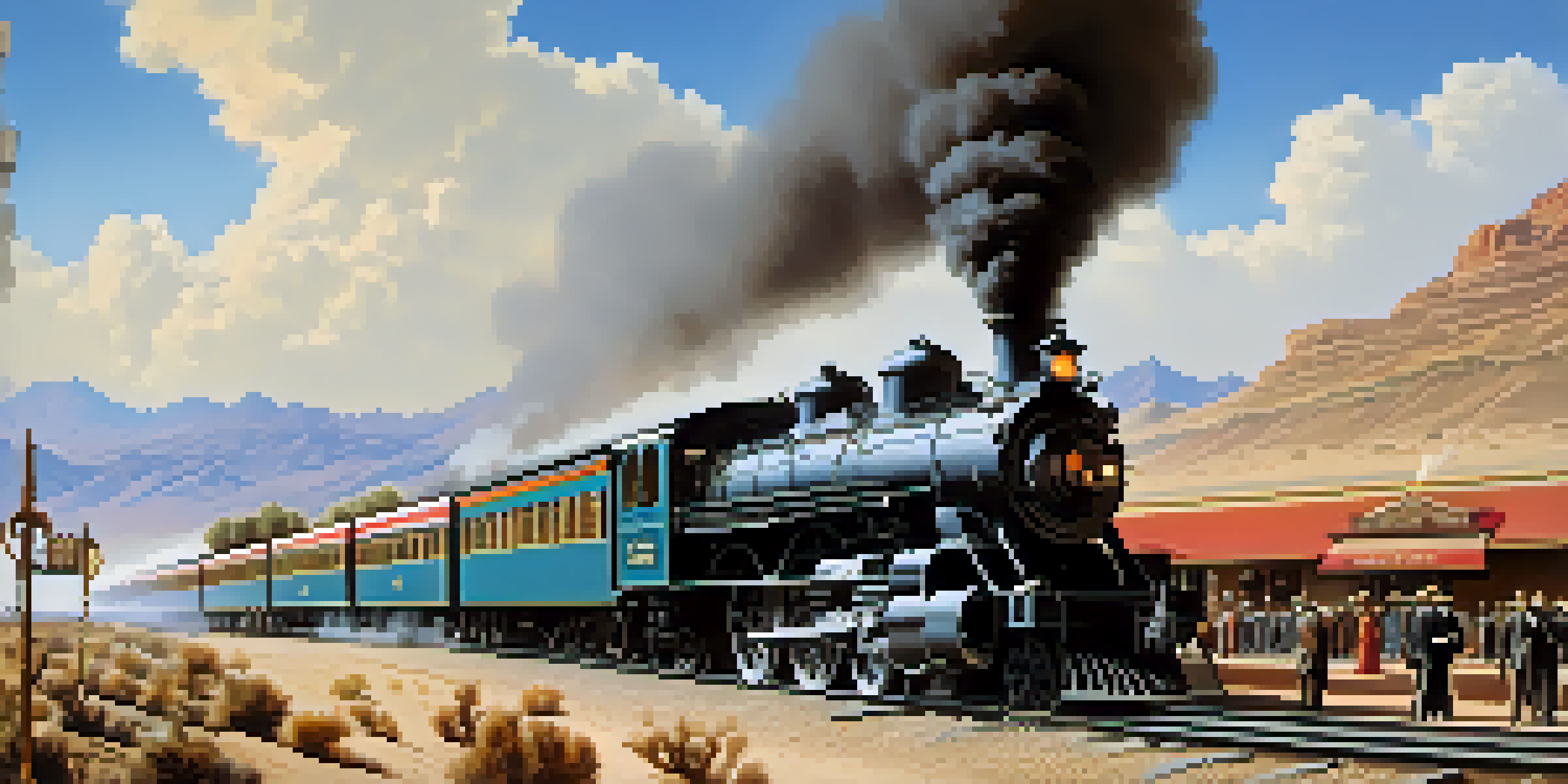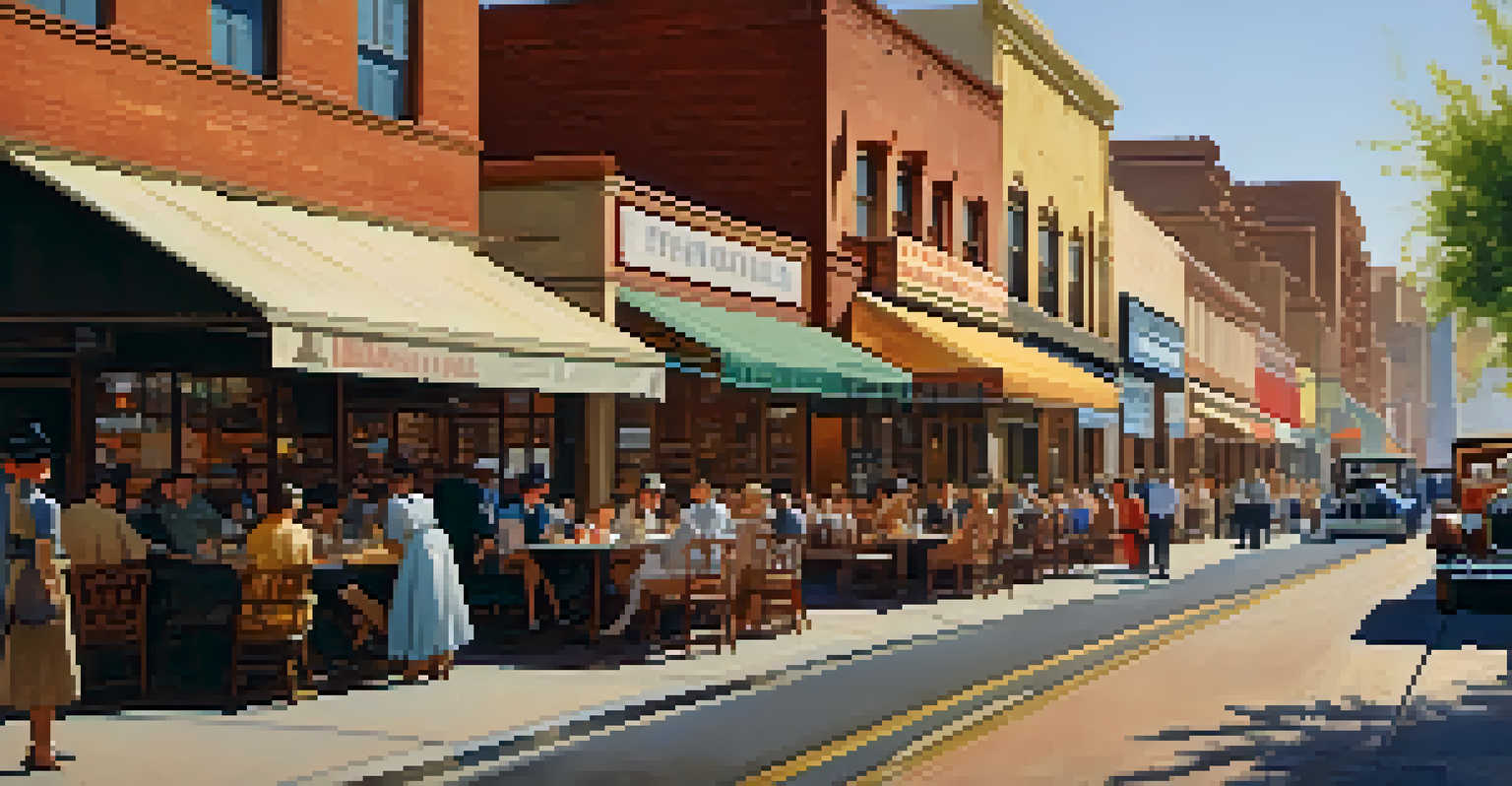The Impact of the Railroad on Phoenix's Development

The Arrival of the Railroad in Phoenix: A Game Changer
In the late 19th century, the arrival of the railroad marked a pivotal moment in Phoenix's history. The Southern Pacific Railroad connected the city to other major hubs, opening up new avenues for trade and travel. Suddenly, what was once a remote settlement became accessible, drawing in settlers and businesses alike.
The railroads are the arteries of commerce and must be treated as such.
Before the railroad, Phoenix was primarily an agricultural community, reliant on irrigation from the Salt River. However, with the railroad's arrival, farmers could transport their goods to larger markets, boosting the local economy. The convenience of rail travel also made it easier for newcomers to settle in the area, leading to a population boom.
As the railroad expanded further, it not only facilitated commerce but also encouraged the growth of various industries in Phoenix. This transformation laid the groundwork for the city's future as a bustling urban center and set the stage for its rapid development in the decades to follow.
Economic Growth: Railroads as Catalysts for Business
The influx of people and goods due to the railroad significantly spurred economic growth in Phoenix. With new businesses emerging to meet the needs of a growing population, the city began to thrive. Retail shops, hotels, and restaurants sprang up, creating jobs and attracting even more residents.

Moreover, the railroad facilitated trade beyond the local market, allowing Phoenix to become a distribution point for agricultural products from surrounding areas. This connection to larger markets meant that local farmers could sell their goods at better prices, further enhancing the economy.
Railroads Boosted Phoenix's Economy
The arrival of the railroad spurred economic growth by enabling trade, attracting new businesses, and creating jobs.
As industries flourished, Phoenix attracted investors and entrepreneurs, creating a vibrant business landscape. The railroad played a crucial role in establishing Phoenix as a regional economic powerhouse and laid the foundation for its future growth.
Cultural Exchange: Railroads Bring Diversity to Phoenix
The railroad was not just a conduit for commerce; it also played a vital role in facilitating cultural exchange. As people from different regions traveled to Phoenix, they brought their customs, traditions, and cuisines, enriching the local culture. This melting pot of influences helped to shape the unique identity of Phoenix.
Transportation is the backbone of the economy and the lifeblood of a community.
Events, festivals, and markets that celebrated this diversity began to emerge, fostering a sense of community among residents. The railroad made it possible for people to share their experiences and traditions, creating a vibrant cultural tapestry in the city.
As Phoenix grew, so did its reputation as a welcoming place for newcomers. This openness to diversity early on helped the city become a hub of innovation and creativity, further enhancing its appeal and growth.
Urban Development: Shaping the City's Infrastructure
With the railroad's influence spreading, Phoenix underwent significant urban development. Streets were laid out, and essential infrastructure like schools and hospitals began to emerge. The convenience of rail travel made it easier for city planners to envision and execute expansion plans.
As the city grew, neighborhoods developed around the railway stations, creating vibrant communities that thrived on accessibility. This pattern of development laid the groundwork for modern Phoenix, where transportation remains a key factor in urban planning.
Cultural Diversity Flourished
The railroad facilitated cultural exchange, bringing diverse customs and traditions that enriched Phoenix's identity.
The railroad also prompted improvements in public transportation systems, making it easier for residents to commute and access services. This interconnectedness helped shape the layout of the city and fostered a sense of community among its inhabitants.
The Impact of Railroads on Agriculture in Phoenix
The railroad revolutionized agriculture in Phoenix, allowing farmers to access wider markets for their produce. With the ability to transport goods quickly and efficiently, local farmers could sell their crops to distant cities, increasing their income and encouraging further agricultural development. This connection was vital for a region that heavily relied on farming.
Moreover, the railroad provided access to essential supplies and equipment, helping farmers enhance their productivity. This influx of resources allowed for the cultivation of a variety of crops, contributing to the region's agricultural diversity.
As agriculture thrived, it played a crucial role in supporting the growing population of Phoenix. The synergy between the railroad and local farming created a sustainable economic model that would benefit the city for years to come.
Transportation Revolution: Beyond the Railroad
The arrival of the railroad set the stage for a broader transportation revolution in Phoenix. As the city expanded, the need for efficient transportation options grew, leading to the development of roadways and later, highways. This evolution allowed for greater connectivity not just within the city, but also with neighboring regions.
With the foundation laid by the railroad, Phoenix became a strategic hub for transportation, attracting new industries and opportunities. The interconnectedness of different transport systems fostered economic growth and made the city a vital player in the southwestern United States.
Infrastructure Development Expanded
The influence of the railroad led to significant urban development, shaping the city's infrastructure and community layout.
This transportation revolution continues to evolve today, with public transit options expanding to meet the needs of a growing population. The legacy of the railroad persists, shaping the way residents navigate their city.
Long-term Effects: The Railroad's Legacy in Phoenix
The impact of the railroad on Phoenix's development is still felt today. The city has transformed from a small agricultural community into a bustling metropolis, with the railroad serving as the catalyst for this change. Its legacy is evident in the infrastructure, economy, and culture of the city.
As Phoenix continues to grow, the principles established by the railroad's arrival remain relevant. The need for connectivity, commerce, and community is as important now as it was over a century ago.

Reflecting on this history helps us appreciate the importance of transportation in shaping urban landscapes. The railroad not only built Phoenix but also laid the groundwork for its bright future.